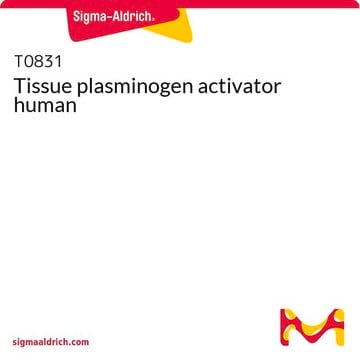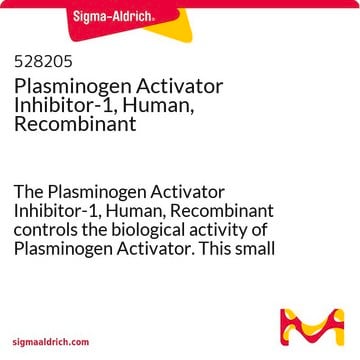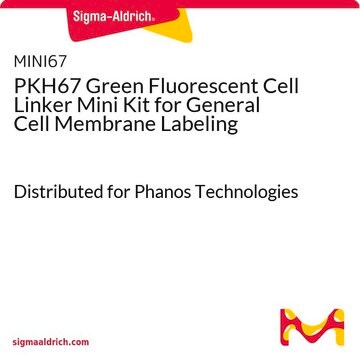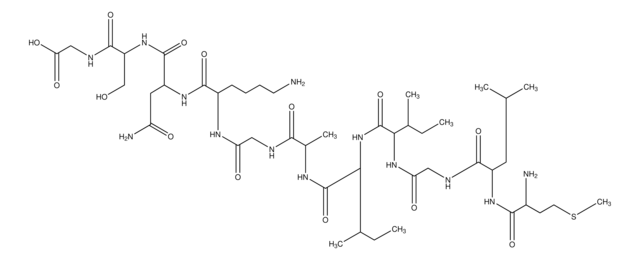T2943
Tissue plasminogen activator chromogenic substrate
≥95% (HPLC), solid
Synonym(s):
TPA Activity Assay
Sign Into View Organizational & Contract Pricing
All Photos(1)
About This Item
Recommended Products
Quality Level
Assay
≥95% (HPLC)
form
solid
mol wt
apparent mol wt 658.9
solubility
methanol: water (1:9): 25 mg/mL
storage temp.
2-8°C
Related Categories
General description
Tissue plasminogen activator chromogenic substrate is a highly sensitive chromogenic peptide substrate for tissue plasminogen activator (tPA). It shows different sensitivity to native single-chain tPA (sc-tPA) and its fully active two-chain form (tc-tPA).
Application
Tissue plasminogen activator chromogenic substrate has been used:
- in tissue plasminogen activator inhibition assay
- to determine the plasminogen activator (PA) activity by studying the glycosylation properties of tissue plasminogen activator (tPA) activities in effusions using concanavalin A-Sepharose (conA-S) chromatography
- in inhibition assays and complex formation analyses of wild type (WT) neuroserpin (NS) and its variants
Storage Class Code
11 - Combustible Solids
WGK
WGK 3
Flash Point(F)
Not applicable
Flash Point(C)
Not applicable
Personal Protective Equipment
dust mask type N95 (US), Eyeshields, Gloves
Choose from one of the most recent versions:
Certificates of Analysis (COA)
Lot/Batch Number
Don't see the Right Version?
If you require a particular version, you can look up a specific certificate by the Lot or Batch number.
Already Own This Product?
Find documentation for the products that you have recently purchased in the Document Library.
Mohammad Farhan Ali et al.
Scientific reports, 7, 42987-42987 (2017-02-24)
Neuroserpin (NS) mediated inhibition of tissue-type plasminogen activator (tPA) is important for brain development, synapse formation and memory. Aberrations in helix F and β-sheet A movement during inhibition can directly lead to epilepsy or dementia. Conserved W154 residue in a
Mark W C Hatton et al.
The Journal of laboratory and clinical medicine, 147(1), 27-35 (2006-01-31)
The VX2 tumor is derived from a papilloma virus-induced rabbit epithelial cell line. If VX2 tumor cells (trapped in a plasma clot) are introduced intravenously into NZW rabbits, the cells lodge in the lung capillary bed and produce tumors. Independently
Shadabi Bano et al.
IUBMB life, 72(10), 2180-2193 (2020-08-23)
Heparin cofactor II (HCII) is predominantly expressed in the liver and inhibits thrombin in blood plasma to influence the blood coagulation cascade. Its deficiency is associated with arterial thrombosis. Its cleavage by neutrophil elastase produces fragment that helps in neutrophil
Mohammad Farhan Ali et al.
Biochimica et biophysica acta. Proteins and proteomics, 1868(4), 140363-140363 (2020-01-20)
Neuroserpin (NS) is predominantly expressed in brain and inhibits tissue-type plasminogen activator (tPA) with implications in brain development and memory. Nature of conformational change in pathological variants in strand 6B and helix B of NS that cause a relatively mild
Mahdieh Bayat et al.
Journal of biotechnology, 280, 1-10 (2018-05-29)
The aim of the present study was to investigate the effect of three routine drug excipients, as osmolytes, in three different concentrations, on structure, thermal stability and the activity of single-chain (sc-) tenecteplase. To see the influence of trehalose, mannitol
Our team of scientists has experience in all areas of research including Life Science, Material Science, Chemical Synthesis, Chromatography, Analytical and many others.
Contact Technical Service








